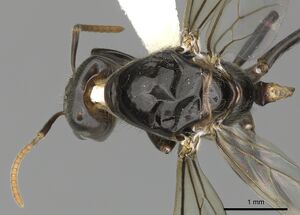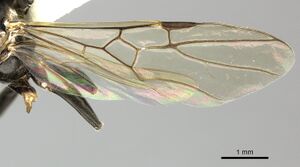Azteca quadraticeps
| Azteca quadraticeps | |
|---|---|

| |
| Scientific classification | |
| Kingdom: | Animalia |
| Phylum: | Arthropoda |
| Class: | Insecta |
| Order: | Hymenoptera |
| Family: | Formicidae |
| Subfamily: | Dolichoderinae |
| Tribe: | Leptomyrmecini |
| Genus: | Azteca |
| Species: | A. quadraticeps |
| Binomial name | |
| Azteca quadraticeps Longino, 2007 | |
This species is known only from queens. They have been collected in lowland to mid-elevation (700m) rainforest in the Atlantic lowlands of Costa Rica. A queen has also been collected in Nicaragua from a flight trap placed in a pasture adjacent to a moist tropical forest.
Identification
Longino (2007) - Queen with the same characters as Azteca flavigaster, differing only in the larger size. It differs from Azteca velox in the more quadrate head shape, less narrowed anteriorly and with less rounded sides.
Azteca quadraticeps is in a cluster of species that are difficult to distinguish: A. flavigaster, Azteca nigra, Azteca sericeasur, and A. velox. It is likely that the workers of A. quadraticeps have been collected and either left unidentified or misidentified. One possibility is that A. quadraticeps is an Atlantic slope version of A. flavigaster, and Atlantic slope worker co`llections identified as A. flavigaster are A. quadraticeps. Other possibilities are that A. quadraticeps workers masquerade as A. velox, A. nigra, or smaller workers of A. sericeasur.
Keys including this Species
Distribution
Latitudinal Distribution Pattern
Latitudinal Range: 11.01666667° to 10.35°.
| North Temperate |
North Subtropical |
Tropical | South Subtropical |
South Temperate |
- Source: AntMaps
Distribution based on Regional Taxon Lists
Neotropical Region: Costa Rica (type locality), Nicaragua.
Distribution based on AntMaps
Distribution based on AntWeb specimens
Check data from AntWeb
Countries Occupied
| Number of countries occupied by this species based on AntWiki Regional Taxon Lists. In general, fewer countries occupied indicates a narrower range, while more countries indicates a more widespread species. |

|
Estimated Abundance
| Relative abundance based on number of AntMaps records per species (this species within the purple bar). Fewer records (to the left) indicates a less abundant/encountered species while more records (to the right) indicates more abundant/encountered species. |

|
Biology
|
Castes
Queen
Images from AntWeb

| |
| Holotype Azteca quadraticeps. Queen (alate/dealate). Specimen code jtlc000005714. Photographer Ryan Perry, uploaded by California Academy of Sciences. | Owned by INBC. |
    
| |
| Queen (alate/dealate). Specimen code jtlc000009422. Photographer Ryan Perry, uploaded by California Academy of Sciences. | Owned by JTLC. |

| |
| . | |
Nomenclature
The following information is derived from Barry Bolton's Online Catalogue of the Ants of the World.
- quadraticeps. Azteca quadraticeps Longino, 2007: 45, figs. 3, 4A, 5, 6A, 6B, 8 (q.) COSTA RICA.
- Type-material: holotype queen, 2 paratype queens.
- Type-locality: holotype Costa Rica: Prov. Limón, Tortuguero, 10°32’N, 83°31’W, 5 m., 1.vii.1985, #0389-s (J. Longino); paratypes with same data.
- Type-depositories: INBC (holotype); MCZC, USNM (paratypes).
- Distribution: Costa Rica.
Unless otherwise noted the text for the remainder of this section is reported from the publication that includes the original description.
Description
Queen
Holotype: HLA 1.84, HLB 1.81, HW 1.72, AHW 1.28, SL 1.19, EL 0.46, OC 0.09, MTSC 33.
(n=6): HLA 1.78 (1.70–1.84), HW 1.71 (1.62–1.79), SL 1.16 (1.11–1.19), CI 96 (93–98), SI 65 (64–66).
Palpal formula 6,4; ocelli small; middle and hind tibia with prominent pectinate apical spur; dorsal surface of mandible with small piligerous puncta, setae in puncta short, subdecumbent, interspaces between puncta smooth and shiny on apical half of mandible, gradually becoming faintly microareolate at base; medial and lateral clypeal lobes at about same level; head subquadrate, posterior margin not strongly cordate, very shallowly excavate; petiolar node tall, strongly compressed into thin scale at apex; posteroventral petiolar lobe evenly convex from front to back; scape with abundant erect setae, about as long as one half maximum width of scape; middle and hind tibia with abundant erect setae, longest of these about as long as one third maximum width of tibia (MTSC 25–35); sides of head without erect setae; posterior margin of head with erect setae; pronotum with erect setae on posterior margin; mesoscutum, scutellum, and propodeum with abundant erect setae; petiolar node with rim of erect pubescence and sparse longer erect setae, 1–2 pairs of erect setae extending above apex in profile, posterior border of sternal lobe of petiole with uniform layer of short erect setae; gastral terga with sparse long erect setae; most of face dark brown, with lighter orange coloration restricted to anterior malar area near mandibular insertions and antennal fossa.
Type Material
Holotype alate queen: Costa Rica, Prov. Limón, Tortuguero, 10°32'N, 83°31'W, 5m, 1 Jul 1985 (J. Longino# 0389-s). Instituto Nacional de Biodiversidad, specimen code JTLC000005714.
Paratypes: same data as holotype; 1 alate queen. JTLC000005715, Museum of Comparative Zoology, 1 alate queen JTLC000009450, National Museum of Natural History.
Etymology
The name refers to the somewhat quadrate shape of the head. Its close relative, Azteca velox, has more rounded sides of the head.
References
References based on Global Ant Biodiversity Informatics
- Longino J. T. 2007. A taxonomic review of the genus Azteca (Hymenoptera: Formicidae) in Costa Rica and a global revision of the aurita group. Zootaxa 1491: 1-63

